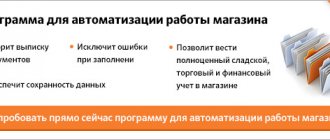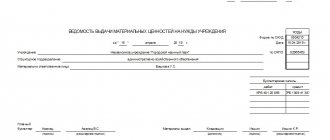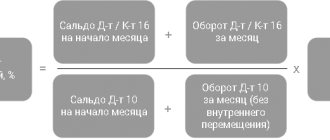How to organize inventory accounting
If the institution does not have a lot of material assets, then it is enough to reflect their receipt in accounting and further write-off when worn out.
use, transfer. That is, it is not necessary to fill out a warehouse journal; Keeping records of material assets is justified if the enterprise has a large stock of material assets, and their use implies movement between structural divisions. This approach makes it possible to ensure appropriate control over the safety and intended use of the enterprise’s property. The head of the organization must appoint a responsible employee who will record entries in the journal. Typically, these responsibilities are assigned to the storekeeper or another materially responsible person, for example, a warehouse manager or a housekeeping manager.
Organization of material accounting in the department
Accounting for material resources in a unit is organized and maintained in order to monitor the safety, expediency and use of property released to provide for personnel, the needs of the unit, to ensure the life of military personnel, as well as to maintain the normal educational process. The unit commander organizes the records and is responsible for maintaining them, and the unit sergeant major is responsible for the legal and correct execution of incoming and outgoing documents, and for the timely maintenance of entries in the books. All types of material assets are subject to accounting, regardless of the source of their receipt and methods of acquisition. Accounting in the department is maintained according to the following documents:
- book of availability and movement of material assets in the department;
- book of accounting of material assets issued for temporary use.
These books (forms 26 and 37, respectively) are maintained indefinitely until they are fully used. The pages of the books must be numbered, the books must be laced, sealed with the seal “for packages” of the military unit and registered in the appropriate service unit. For each type of material assets (rocket and artillery weapons, ammunition, engineering equipment, communications equipment, clothing, apartment property, etc.) a separate section is allocated in the accounting book (Form 26). Initial entries in the accounting book are made in the corresponding service of the military unit, subsequent ones - by the battery sergeant major. The initial records are certified by the signature of the head of the service. Materials received or sent (handed over) from the unit are credited (written off) according to the accounting book on the same day. These books must correspond to the availability of material resources in the department. The unit sergeant major issues material assets to military personnel for personal use against signature on a free-form distribution (delivery) sheet. In these cases, other material assets issued to personnel are accounted for in the accounting book. According to the same book, weapons, equipment and property are handed over for repair. In the department, fuel is filled into the tanks of cars according to a statement (form 8, appendix 1 to the order of the USSR Ministry of Defense No. 260 of 1979) against the signature of the drivers. The amount of fuel issued is recorded by the tanker in the waybill (Form 16, Appendix 1 to Order of the USSR Ministry of Defense No. 260 of 1979) for each refueled vehicle. In a unit located separately from its military unit, records of material assets are maintained by persons appointed (Appendix 1 to Order of the USSR Ministry of Defense No. 260 of 1979) by order of the commander of the military unit.
Document form: which one to use
To record the movement of inventory items, use a special journal for the issue of material assets; you can develop a sample yourself. This right is enshrined in Law No. 402-FZ. Or use the unified forms approved by Resolution of the State Statistics Committee of the Russian Federation dated 08/09/1999 No. 66.
For example, to reflect receipts of inventory items, you can use form MX-5 (OKUD 0335005).
To reflect the consumption of material assets, a different form is used - MX-6 (OKUD 0335006).
In military units where strict records of ammunition, weapons and equipment are kept, a special form is used: material inventory log form 26.
Based on these unified forms, the institution has the right to independently develop a form that will meet all the specific features of its activities. Such a form should be approved in the accounting policy or in a separate local order.
Book No.___ accounting for the presence and movement of categorical material assets (Form No. 10)
Explanations for the form
1. The book is intended to record the presence and movement of weapons, equipment, ammunition and other categorical and non-categorical material assets, as well as forms of documents for strict accounting in the service of a military unit (formation), in a warehouse and in the military administration of an association (center).
2. When preparing a book, depending on the number of expected entries, one or several pages are allocated for each item of material assets (in the sequence of their list according to the product classifier).
Each reporting unit (military unit, formation, warehouse, association) is assigned a personal account in several columns (starting from the 20th), of which one column is for the “Total” detail and the required number of columns for the “Of them by categories (grades)” )".
If there are a large number of units (military units, formations, associations, warehouses), additional sheets are allocated for them in the book.
In the book of the fuel and lubricants service of a military unit, the personal account for the unit must have two columns: one for accounting for fuel in kilograms, the second in liters.
3. Initial entries of the basis details in the book are made on the basis of primary accounting documents or data on the balances of material assets taken from the previous book. In the case of transferring balances from the previous book, write down: in column 2 - “Accounting book”, in column 3 - its number, in column 4 - the page of the book, in column 5 - “Transfer of balance”.
For non-categorical material assets, the basis details are not recorded in columns 9 - 13 and 15 - 19.
4. When moving material assets within a military unit (formation, warehouse, association), entries in columns 6 and 7 are not made. In columns 8 - 13 the previous balances are repeated; changes in balances are made in the personal accounts of only those units (military units, formations, storage departments, warehouses, associations) that, according to accounting documents, are recipients (delivers) or suppliers.
5. When producing forms for automobile equipment accounting books, instead of the requisite “Standard stock: minimum maximum_______”, the requisite “Required by state: total ___________, including: combat ________, combat training _________, combat __________, transport __________, training ________” is printed.
To record vehicles by their operation groups, the book contains columns 20 - 24 (for combat vehicles - column 20, combat training - column 21, combat vehicles - column 22, transport - column 23 and training - column 24). and to account for the time the machines are in operation from the moment of production by the plant - columns 25 - 27 (up to 5 years - column 25, from 6 to 10 years - column 26, from 11 or more years - column 27).
When recording automobile equipment in a military unit (formation), a separate page is allocated for each type, name and brand of vehicle in the sequence of the list of vehicle brands provided in the report on the availability and technical condition of automobile equipment.
When writing off automobile equipment, the entry “Written off” is made in column 5, and in column 7 the quantity of equipment is indicated.
6. When accounting for armored and automotive vehicles in the personal account of a unit (military unit, formation, association), a column is allocated for the details “As required by state (sheet).”
7. Accounting for material assets based on specific characteristics (year of manufacture, year of issue, height, size, etc.) in the book is carried out line by line after recording the data of the main accounting transaction. In this case, the following are written down: in column 2, the headings of the lines (for example, “including by year of manufacture”), in column 5 - in separate lines the relevant details (for example, “2009”, “2012”), and in the 6th and subsequent columns - the basis details showing the amount of material assets (for each attribute detail).
8. The reconciliation note is recorded in the book as a regular line. In this case, in column 1 the date of reconciliation is indicated, in column 2 the entry “Reconciled” is made, and the personal accounts are signed by the persons responsible for accounting in the units, in the warehouse (in the services of military units).
How to Journal
Maintaining an accounting register has its own characteristics:
- Only the responsible employee can make entries in the document.
- All property of an enterprise is subject to registration, regardless of quantitative, qualitative and cost characteristics.
- The responsible employee issues valuables to employees and/or financially responsible persons against signature.
- Upon receipt or disposal of inventory items, information is reflected in the accounting register on the same day.
- The final journal data for a specific date must match the actual availability of inventory items.
Components
The journal is kept only in paper form, since financially responsible persons must sign it. The document includes:
- cover;
- even side;
- odd side.
The cover details the organization that handles the storage. In particular, it must contain its full name, OKPO form, type of activity according to OKDM, type of operations performed by it, address, fax and contact telephone number, and, if available, the structural unit in which the journal is opened.
A document for each individual division or warehouse is created individually.
The even-numbered side contains the name of the paper itself, a description of the period (from which date the journal was or was kept), position and signature with a transcript of the financially responsible person who keeps the journal.
A wide table in which the necessary information is entered is located on the odd side and can continue for a long time if necessary. If the magazine is printed on more than three sheets, then all subsequent even pages repeat the contents of the first even one, and all subsequent odd pages repeat the contents of the first odd one. The columns should contain the following information:
- the first is the serial number of recording;
- the second - when the actual transfer of property occurred, the date;
- third - the full name of the person who gives it for storage (if he does this on behalf of any company, then mention of it in this column is also mandatory);
- fourth - what type of property is being transferred, as well as the type of packaging (for example, Alenka candies in cardboard boxes);
- fifth - unit of measurement of goods (g, kg, tons);
- sixth - its quantity and mass (or only weight);
- seventh - cost;
- eighth - price;
- ninth – description of the storage premises, including address details and contact telephone number;
- tenth and eleventh - number and date of admission papers;
- then three columns make up a description of the acceptance for storage: what date this occurred, a signature with a transcript of the financially responsible person for this operation;
- columns fifteen to eighteen are responsible for the description of the return (the field for checking goods by quantity and quality is filled in), including the full name of the returner, his signature with a transcript, as well as the number and date of the return document;
- columns nineteen to twenty-one are created to indicate the full name, date and signature of the bailor after receipt, indicating that the goods and materials were received in full and he has no complaints about the storage process.
Some columns can be left blank if there is no data. You can also put dashes.
How to fill
The material assets accounting journal (filling sample) is no different in structure from ordinary accounting registers. It consists of a title page and pages arranged in the form of a table.
The title page is filled out once - when creating a document. The following information is provided here:
- name of the institution and name of the structural unit;
- the period for which entries are made (month, quarter, year, depending on the number of transactions);
- information about the position and full name is indicated. employee responsible for maintaining the register.
It is acceptable to provide additional information. For example, type of activity according to OKVED, TIN, OKPO, KPP and other registration data.
The tabular part of the document is filled with data on the movement of inventory items:
- The number is entered in order.
- Then enter the date of the transaction.
- The data of the primary document on the basis of which the entry is made is indicated. For example, when receiving goods and materials, indicate the number and date of the invoice. Upon disposal - the number and date of the act for write-off, transfer.
- Specify the recipient. If this is an employee of the institution, then write down the position and full name, if it is a third-party company, then indicate the name of the company.
- Register the name of the inventory, unit of measurement and cost for the product, then indicate the quantity and amount based on the quantity issued (received).
You can download the completed wealth register for free.
Book's contents
The “Wealth Accounting Book,” a sample of which is presented below, consists of two types of pages. The main pages display data on inventory items (each type on a separate page), and the second - verification (last in the book) page is filled out by the persons conducting the verification.
The content of the document is in the form of a table with indicators and their codes according to the corresponding classifiers. The document must indicate full name. and positions of materially responsible persons.
Each page of the document contains the following information:
- name of the institution, structural unit, full name responsible person;
- data on the storage location of inventory items (warehouse, rack, cell);
- name of goods and materials;
- unit of measurement;
- unit price;
- brand, grade, size.
Below is a table that directly displays information about the movement of inventory items. Here you need to indicate:
- the date the entry was made;
- number and date of drawing up the document that became the basis for the operation;
- name of the organization or full name persons from whom the inventory items were received or to whom they were issued;
- receipt, expense and balance of inventory items on a specific date;
- date of control, full name and signature of the responsible person.
Form 0504042 “Book of records of material assets”, as a rule, is filled out by the storekeeper (or other financially responsible person). The pages of the book should be numbered and laced. On the last page indicate the total number of sheets of the book. The signatures of the head of the institution and the chief accountant, as well as the seal of the institution, must also appear here.








